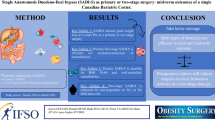Summary
In a prospective randomized study, total parenteral alimentation was compared with early postoperative enteral alimentation in a group of patients who had undergone esophageal resection. In addition to mechanical problems with the jejunal catheter abdominal complications arose during enteral alimentation (meteorism, distension), leading to discontinuation in one-third of cases. The limited prognostic value of ultrasound examination of the abdomen — now often used postoperatively as a decisive aid to diagnosis — is a further serious disadvantage; overall, since there are no particulars in which enteral alimentation can be shown to be superior to parenteral alimentation, it no longer seems justified in the early postoperative phase. The jejunal catheter has, however, proved its worth as a means of direct access to the intestine that can be exploited any time after the initial postoperative period (a week to some months after surgery). For this reason we now insert a jejunal catheter routinely following esophagectomy or gastrectomy.
Zusammenfassung
In einer prospektiven, randomisierten Studie wurde bei 40 Patienten mit Oesophagusresektion die totale parenterale Ernährung der frühen postoperativen enteralen Ernährung gegenübergestellt. Neben mechanischen Problemen des Jejunalkatheters zeigten sich abdominelle Komplikationen (Meteorismus, Distension), die in einem Drittel der Fälle zum Abbruch der enteralen Nährstofzufuhr führten. Die Einschränkung der Aussagekraft der abdominellen Sonographie — heute ein oft entscheidendes Diagnosticum der postoperativen Phase — kommt als weiterer schwerwiegender Nachteil hinzu, so daß bei einer in allen Parametern fehlenden eindeutigen Überlegenheit gegenüber der parenteralen Ernährung der Einsatz dieser Methode in der frühen postoperativen Phase nicht mehr gerechtfertigt erscheint. Dagegen bewährt sich der Jejunalkatheter als späterer (eine Woche bis Monate) jederzeit in Gang zu bringender direkter Zugangsweg zum Intestinum, weshalb seine Einlage bei Oesophagektomie und Gastrektomie an unserer Klinik zum Routinevorgehen geworden ist.
Similar content being viewed by others
Literatur
Tinckler LF (1965) Surgery and intestinal motility. Br J Surg 2:140–150
Wells C (1964) Postoperative gastrointestinal motility. Lancet 1:4–10
Rothnie NG, Harper RAK, Catchpole BN (1963) Early postoperative gastrointestinal activity. Lancet 11:64–67
Woods JH (1978) Postoperative ileus: a colonic problem? Surgery 84:527
Delany HM, Carnevale NJ, Garvey JW (1973) Jejunostomy by a needle catheter technique. Surgery 73:786–790
Delany HM (1977) Postoperative nutritional support using needle catheter feeding jejunostomy. Ann Surg 186:165–170
Bongiorno FP (1982) The needle catheter jejunostomy: present indications, future use. Surg Rounds 5:52–61
Schattenkerk ME (1983) Needle catheter jejunostomy (NCJ) for early postoperative feeding: experience in 210 patients. Neth J Surg 35:163–166
Hoover HC (1980) Nutritional benefits of immediate postoperative jejunal feeding. Am J Surg 139:153–159
Yeung CK (1979) Fine needle catheter jejunostomy - an assessment of a new method of nutritional support after major gastrointestinal surgery. Br J Surg 66:727–732
Merkle NM, Dölp R, Wiedeck M (1980) Über die postoperative enterale Ernährung nach Abdominaleingriffen. Chirurg 51:524–528
Siewert JR (1986) Ösophaguskarzinom: Transthorakale Ösophagektomie mit regionaler Lymphadenektomie und Rekonstruktion mit aufgeschobener Dringlichkeit. DMW 111:647–651
Blebea J, King TA (1986) Intraperioneal infusion as a complication of needle catheter feeding jejunostomy. J Par Ent Nutr 9:758–759
Hulten L (1980) Enteral alimentation in the early postoperative course. J Par Ent Nutr 4:455–459
Rowlands BJ (1977) Nitrogen-sparing effect of different feeding regimes in patients after operation. Br J Anaesth 49:781
Liebe S von, Kemen M, Zumtobel V (1987) Untersuchungen zur Unverträglichkeit der frühpostoperativen enteralen Ernährung. Infusionstherapie 14:7
Sagar S, Harland P, Shields R (1979) Early postoperative feeding with elemental diet. Br Med J 1:293–295
Author information
Authors and Affiliations
Rights and permissions
About this article
Cite this article
Brandmair, W., Lehr, L. Frühe postoperative enterale Ernährung nach Oesophagusresektion. Langenbecks Arch Chiv 373, 248–255 (1988). https://doi.org/10.1007/BF01261818
Received:
Issue Date:
DOI: https://doi.org/10.1007/BF01261818




